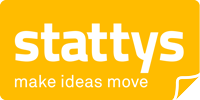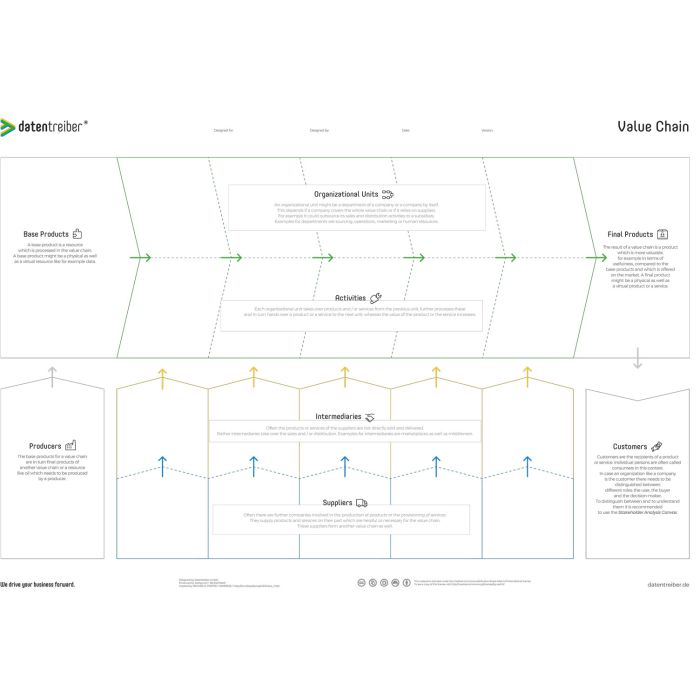Value Chain A0 (47" x 33") synthetitisches Papier (EN)
Why Value Chain?
If you want to design new business models, develop new products or services, or optimize your own business processes, you first need to know and understand the value chain in the respective industry.The value chain describes how, for example, simple, low value raw materials can be used to create complex, high value products, which organizational units - companies, divisions, departments or people - are involved in the production process and what activities they take along the chain. By visualizing the value chain, you recognize supply gaps and optimization potential.You can use the canvas value chain to consider outsourcing certain activities to suppliers or using intermediaries to distribute the products to customers. On the other hand, your company may be too dependent on intermediaries and numerous suppliers. Canvas will then help you decide which outsourced activities should be incorporated into the business. Use the canvas value chain to visualize and analyze the value chains of your business customers - for example, with the goal of expanding your product portfolio or identifying new customer segments. As part of the development of a data strategy, the canvas value chain enables potential applications with high optimization potential to be identified.
What is Value Chain?
The value chain Canvas is a visual collaboration tool for interdisciplinary teams.For example, bring together the department heads from purchasing, production, marketing, and sales to get an overview of the activities and processes within your business. When designing the value chain for your own business, the organizational units (green area above) are your business units, departments or people or roles, as well as partner companies, which, for example, take over distribution to the customer or organize purchasing.The activities are the activities of the respective organizational units that directly contribute to value creation, such as production, logistics, marketing, sales and so on. At the end of the value chain are one or more products or services (right side above), which are sold to the customers (right side below. On the left side you will find the basic products (above) and the producers of these products (below).In addition, there are suppliers (blue area below), which provide specific services, raw materials, tools, etc. You may not buy these services directly, but rely on intermediaries (yellow area below) such as marketplaces.the event that you analyze the value chain of your customers, you are yourself a supplier or an intermediary.The value chain Canvas is based on the concept of Value Chain Porter.
How to use Value Chain?
First, decide whether you want to visualize and analyze the value chain of your own company or that of your (current or potential) customers. Then either start on the right side and think about who your customers are or your clients' customers and what you (or your customers) want to sell. Or you start on the left side with the starting products and the producers.
Define the value chain.
Then work from left to right or right to left along the value chain and consider in each case which individual steps are necessary to produce and distribute the end products from the source products, and which organizational units perform these tasks. You may need several iterations. Start roughly and refine the steps and organizational units as long as necessary.
Complete the suppliers and intermediaries.
Your company or that of your customers will probably buy additional services, raw materials, tools, machines, software, data, etc. These products are themselves the result of a value chain that is orthogonal to the value chain of your company or that of your customers. You will find these orthogonal value chains simplified in the lower part of the canvas. First, consider which services you or your customers are buying and in which step of the value added chain these services are used. Then you identify the corresponding suppliers, ie companies that provide the services and, if necessary, the intermediaries, ie companies that distribute the services (for example, a marketplace).
Analyze the value chain.
Before analyzing the value chain, make sure it is complete and consistent. Depending on the project objective, ask yourself the following questions and answer the questions based on the filled value chain Canvas. The example of the optimization of own business processes:
- Which process steps could I outsource to save costs („Make or Buy“)?
- What outsourced activities could I bring back to the company to expand vertically and / or reduce supplier dependencies?
- Which intermediaries actually bring me added value?
If, on the other hand, your goal is to develop new business models and analyze the value chain of a potential customer or your industry, ask yourself the following questions:
- Who are potential customers along the value chain and what services do you need?
- Where are there gaps in supply or a need to purchase services externally?
- How could the value chain be simplified or shortened?
Links
More information you will find at Datentreiber.
| SKU | 381-DATR403 |
|---|---|
| brand | Datentreiber |
| Größe | 118,9 x 84,1 cm (49" x 33") |
| Material | Synthetisches Papier 210 g/m² |
| Gewicht in kg | 0.21 |
| Versand | Wir versenden in der Regel in 0-2 Tagen mit DHL oder Deutsche Post. |
| Umsatzsteuer 19 % oder 7 % für EU-Bestellungen | Erfolgt die Lieferung in einem EU-Land außerhalb Deutschland, sollten Sie unbedingt Ihre UStId-Nr. auf das entsprechende Feld während Ihrer Bestellung eingeben. Ohne gültige UStId-Nr. sind wir verpflichtet Ihnen 19 % bzw. 7 % MwSt. zu berechnen |
| Online-Shop Angebot | Die Angebote im Online-Shop gelten nur für Firmen, Gewerbetreibende, Freiberufler und Vereine sowie Behörden, Schulen und Universitäten. Alle Preise gelten zzgl. MwSt. für Lieferungen in Deutschland und in EU ohne UmSt.-Id.Nr. |







